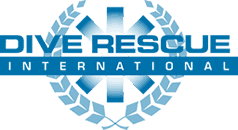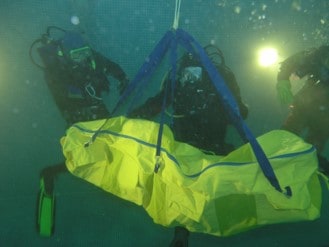Dive Rescue I is the internationally renowned three day (24 hour) training program for certified divers and surface support personnel. Successful completion of the Dive Rescue I program provides basic methods and skills necessary for a Public Safety Diver to function safely and effectively at a water accident. From scene evaluation to incident debriefing, this program covers it all. Diving and surface support personnel learn to apply the latest techniques in underwater rescue and recovery to prepare them to respond effectively and safely to water incidents.
This program is presented in the classroom, pool and open-water to allow students to become familiar with the techniques prior to field scenarios. Successful completion of this program is measured in class participation (including 2 dives) and an end of program comprehensive test.
Key training topics and the associated objectives include:
Drowning and PSD Fatalities
Name the effects of cold-water shock on the body
Explain the role of hypothermia and mammalian diving reflex in cold-water near-drowning cases
Prioritize the critical tasks performed on drowning victims
Identify the importance of establishing a standard of care that is sustained from arrival on scene to the transfer to higher level medical personnel
Team Organization and Management
Define the relationship between risk management and providing a measurable level of service
Distinguish between discretionary time and nondiscretionary time
Describe the criteria for selecting dive rescue specialists that support your mission
Identify and define training needs of the individual dive rescue specialist and training needs of the dive rescue team
Specify the importance of equipment standardization for safety, maintenance and serviceability
Establish the need to purchase safe and updated equipment
Search Pattern
Identify and define the utility of the basic search patterns executed in class
Explain the criteria for the selection and execution of search patterns
Illustrate the importance of using required equipment
Review the need for following the NFPA Guidelines
Elaborate on situations that call for shore based and boat based search patterns
Compare and contrast the safety protocols for executing with one diver vs. two divers
Scene Evaluation
Explain the terms Risk/Benefit Factor, Rescue Mode, and Recovery Mode
Identify the components of preplanning
Describe the procedure for creating a last-scene-point
Discuss interview techniques and witness follow-up
Describe the techniques used if no witnesses are available
Victim Retrieval
Describe the criteria that determine a missions mode of operation as rescue or recovery
Clarify the procedure used by diver and tender when the body is located
Review the process of resuscitation
Explain the conditions affecting body refloat
Service to the Family, Media and Other Agencies
Explain the objectives of a family liaison
Identify the need to communicate operational priorities to the family
Describe the process of building a relationship with the media and other agencies
Vehicle-in-Water Accidents
Identify hazards specific to vehicle-accidents-in-water and describe the precautions divers use
Describe the techniques for handling vehicles as evidence
Identify differences between handling vehicles in rescue and recovery mode
Keeping an emphasis on safety, explain the procedures used when extricating vehicles and victims
Explain post dive considerations for vehicle-in-water missions
NFPA Standards
Upon completion of this program, including in-water work, personnel address several NFPA standards set forth for the Technician Level. Surface Support personnel who complete this program address the NFPA standards set forth for the Awareness and Operations Level.
Be Sure to Bring
All students must bring: US Coast Guard approved P.F.D. with knife and whistle, adequate clothing and protection from the environment and pen and paper for note-taking and sketching. Diving students must provide their own equipment: Scuba regulator: recently serviced and environmentally protected with alternate air source (i.e.: octopus, Air II, etc.), timing device, depth and submersible pressure gauges, BC with oral/power inflator, two tanks with current Hydro & VIP, mask, snorkel, fins, weight belt and two cutting tools (knife, wire cutters, or trauma shears.)
Prerequisites
All students must be a member of a public safety agency and at least 18 years of age. Students must read and complete a RSTC medical statement prior to attending class. Any diver answering yes to any contraindication must have the form signed by a physician. Diving students must have proof of open water certification.
This program is designed for personnel who are physically fit. Participants are encouraged to participate after successfully completing the IADRS Watermanship Test or testing to a fitness level of 13 MET (Metabolic Equivalents) or greater. Participants with aerobic fitness questions or concerns should consult their physician prior to in-water training. Participants who have poor aerobic fitness may attend this program as surface support personnel with the approval of the instructor.

